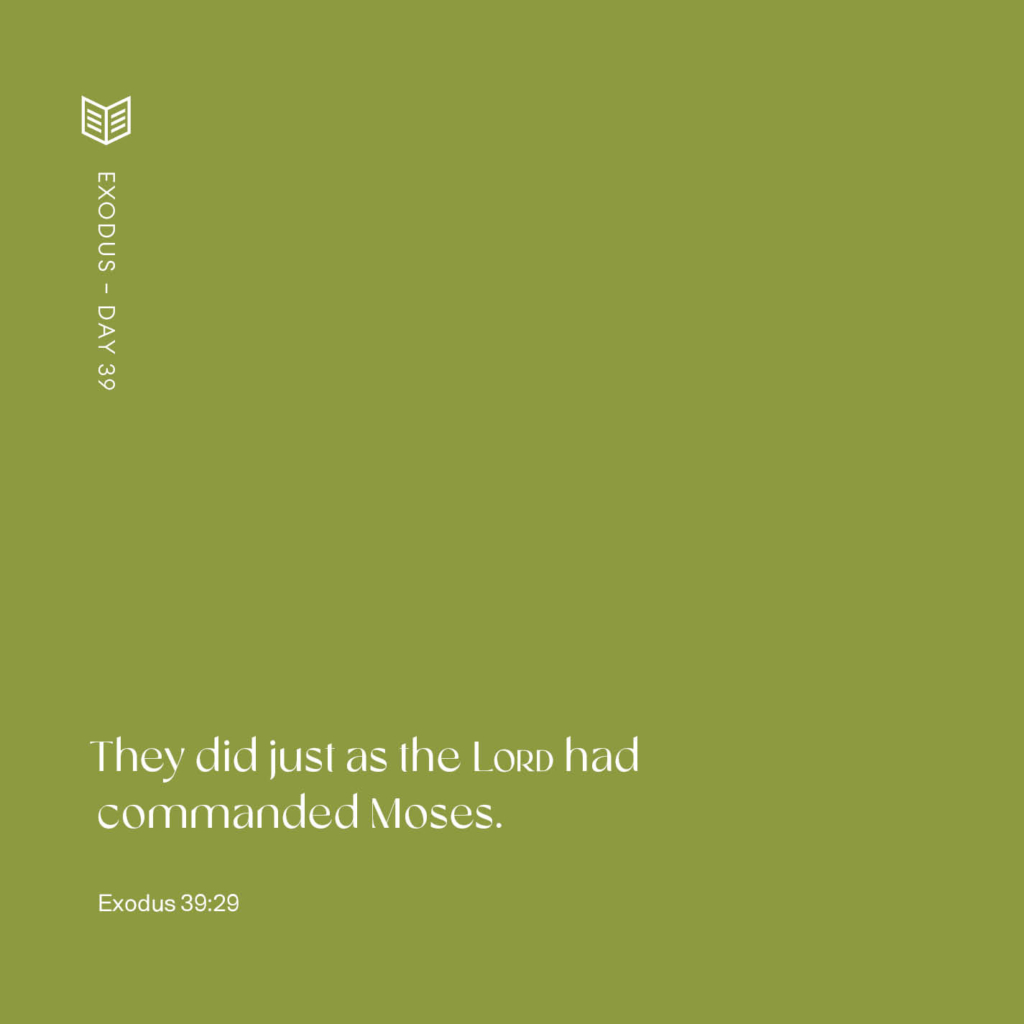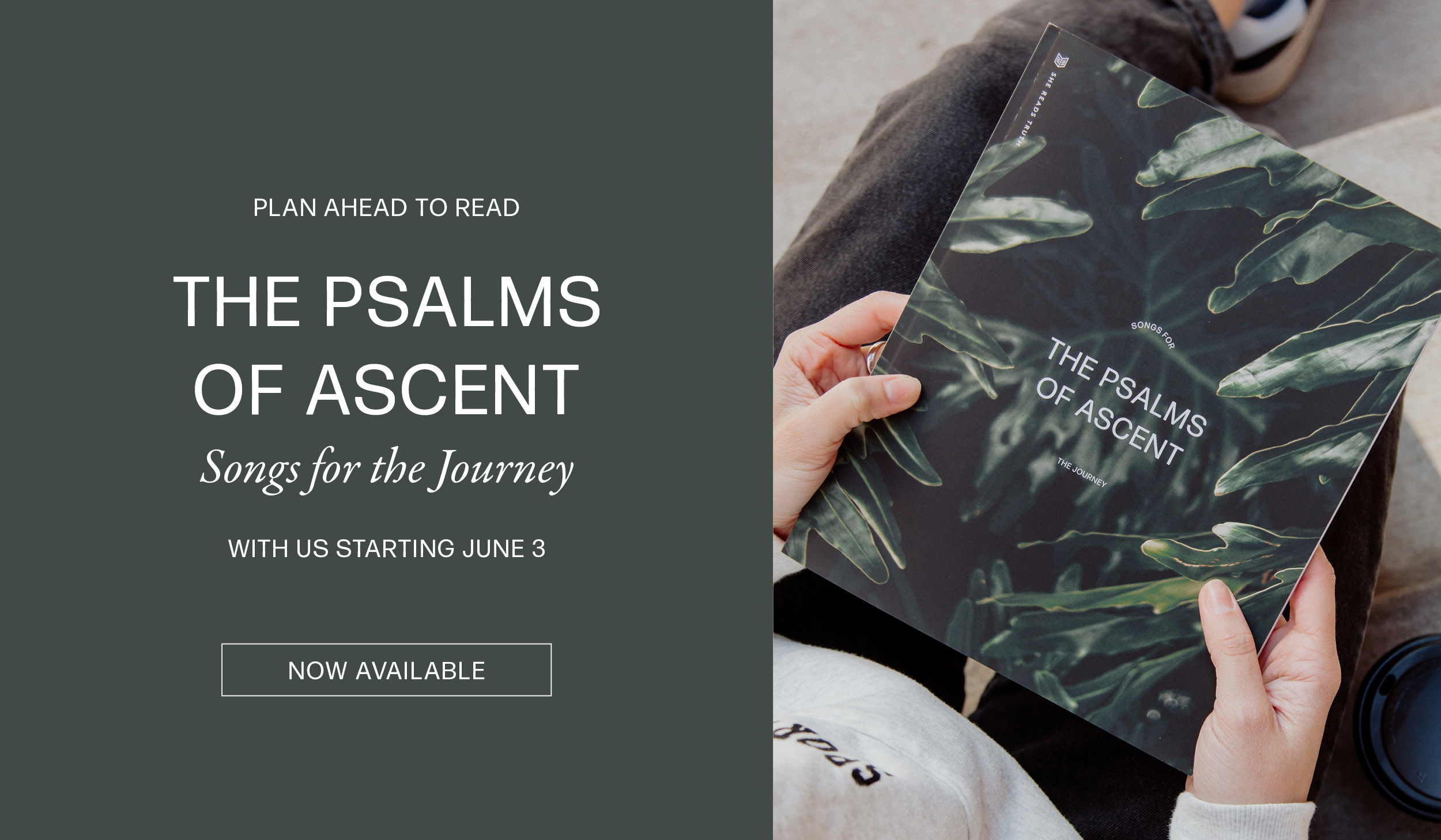I believe with all my heart that these detailed descriptions of the construction of the tabernacle in Exodus are as much the inspired Word of God as my favorite psalm. But for a free-spirited, color-outside-the-lines kind of girl like me, the sheer number of details recorded in these chapters gives me flashbacks to my freshman accounting class.
Why did the Lord instruct Moses to build altars and tables, lampstands and basins, tunics and turbans with such extreme attention to detail? Why were these details recorded so meticulously? All these centuries later, what do they have to teach us about the character of God and our relationship with Him?
Let’s zero in for a moment on Exodus 39, where we find the description of the priestly garments. This was more than a garment. With gold and stones, bells and crowns, this was an ensemble made to take our breath away. But why? Aaron’s robes weren’t designed to turn heads at Fashion Week. They wouldn’t be sold to the highest bidder. So why was such detailed extravagance needed?
Peel away the layers, and we find the answer in a single thread. The scarlet thread mentioned over and over in Exodus 39 is the same thread that is stitched throughout all of God’s Word. It is the thread God used to sew together garments of grace for Adam and Eve after the fall (Genesis 3:21). It is the thread that signaled salvation from Rahab’s window (Joshua 2:18). And most significantly, we see it at the cross, as trails of blood stream down our Savior’s face as evidence of His atonement for our sins.
Aaron’s priestly garments were woven with red thread, a picture of the gospel illustrated by the thread of salvation woven throughout all of God’s Word. The weight of the robe covered with stones was symbolic of the burden of sin; as Aaron slipped it on, I imagine its heaviness reminded him of the weight of his own sin and of ours. The crown on the priest’s head was a shadow of the crown of salvation purchased for us at Christ’s cross.
The garment maker couldn’t have known it, but he was preaching the gospel. Stitch by meticulous stitch, he was proclaiming salvation was near. Through the lens of the cross we see these extravagant robes showcase an extravagant gospel.
It’s possible the craftsmen tasked with the minutiae of the tabernacle felt overwhelmed and even belabored by the tedium of so many details. Obedience can often feel like that. As we shepherd our own children, or serve in other often thankless ways, or pull out our Bibles listening for God’s voice again and again, there are times when we all wonder, Why does all of this matter?
The answer rarely seems to come in the moment, but in hindsight we see that routine obedience to the Lord always reveals the gospel thread. He is using our seemingly small acts of surrender to transform these filthy rags into robes of righteousness. As we trust and obey, we can look back and sigh with gratitude saying we have “done just as the LORD commanded” (Exodus 39:43).



“Woven red thread, a picture of the gospel illustrated by the thread of salvation woven throughout all of Gods word” “the crown of the priest’s head is a foreshadow of the crown of salvation “
“Woven red thread, a picture of the gospel illustrated by the thread of salvation woven throughout all of Gods word”
This was so good, Erin! “The garment maker couldn’t have known it but he was preaching the Gospel.” I don’t think I’ve really thought of the symbolism of the scarlet cord, the weight of the garment and the weight of sin and the crown on their heads. What a foreshadowing of what Jesus did for us! “Extravagant robes” pointing towards an “extravagant gospel.”
@Jennifer Loves Jesus – beautifully said! I wonder if the forbidden fruit in the garden was actually a pomegranate instead of an able like they always show lol
My thoughts exactly. Beautiful to know our obedience is transformed to robes of righteousness so that we can look back and say we did all according to all that God commanded. I would add through the righteousness of Christ imputed to us. Have a blessed day.
What’s with the bells and pomegranates?! The robe of the high priest had a hem ornamented with 72 each of them. This was a robe of distinction and protection. Exodus 28 describes a woven collar with an opening like body armor (v. 32). And the sound of the bells was heard when he enters the sanctuary before the Lord and when he exits, so that he will not die (v 35). How would sound and taste protect life with bells and pomegranates? And if Jesus is in view as the final and Highest Priest, all begins to click in my heart. In the Old Testament the people could not enter the sanctuary to approach God, but they could hear when the high priest was there behind the curtain interceding to God for them. The purest golden bells are like the voice of our Savior, interceding for us. And what is the purest sound to God’s ears? I think it must be prayer to Him. The bells signified the sound of intercession. And the pomegranates? A whole nother rabbit hole! :) The fruit symbolized abundant life. The five points of the peeled back shape was the inspiration or the crown of kings. The intimacy in Song of Songs uses pomegranate imagery all throughout the book. And God commanded 72 of them to be sewn between the bells. All made from the fines yarns of scarlet, blue and purple. Rich in mercy. Rich in love. Protection. Bells and pomegranates. Sound and taste. What do people hear when I enter a room? What do they taste? Fruits of the Spirit come directly to mind. I will ponder this today. Taste and see, listen and pray. Touch the hem of His garment for healing. He protects me with His love. I hear the sound of His voice in my heart. I see the abundance of life in Him. Thank You Jesus. Amen.
Beautiful the thread of gospel woven through scripture. Never thought of the scarlet thread as that.
I was struck with how many time in todays reading was the phrase “as the Lord had commanded Moses.” I found 10 times just in today and I know there have been more as they have been building the tabernacle.
Praying that I would also be doing “as the Lord commanded”
“It’s possible the craftsmen tasked with the minutiae of the tabernacle felt overwhelmed and even belabored by the tedium of so many details. Obedience can often feel like that. As we shepherd our own children, or serve in other often thankless ways, or pull out our Bibles listening for God’s voice again and again, there are times when we all wonder, Why does all of this matter?
The answer rarely seems to come in the moment, but in hindsight we see that routine obedience to the Lord always reveals the gospel thread. He is using our seemingly small acts of surrender to transform these filthy rags into robes of righteousness. As we trust and obey, we can look back and sigh with gratitude saying we have “done just as the LORD commanded” (Exodus 39:43).”
Yes! When we humble ourselves and obey our Lord, His grace will shine through and He will be glorified.
I also saw the symbolism of salvation in these clothes that the high priest wore. The tribal names on the shoulder stones of the ephod reminded me that the priests bore the burden of the people’s sins just as Christ bore the burden of our sin as He offered the sacrifice that would take our sin away.
The names of tribes on the breastpiece symbolized that the priest bore the Israelites on his heart. His service was to be a service of love for his people. Christ laid down His life for us because He loves us. Oh the glorious truth of John 3:16, “For God so loved the world that He sent His only Son that whoever believes in Him should not perish but have everlasting life,” and so many other Bible verses that remind us that God offers us salvation because He loves us!
Also, because He loves us, He will not forget us or forsake us. Isaiah 49:16 states, “Behold, I have engraved you on the palms of my hands …” This was written to the tribe of Judah before they were exiled to Babylon to remind them that the Lord would not forget them and would restore them. God is the same today as He was then. He does not forget His own. Nothing will separate His people from His love (Romans 8:31-39).
The breastpiece also reminds me of the breastplate of righteousness in Ephesians. We are only able to be righteous because we take off our old nature and put on the righteousness of Christ (Colossians 3). What was the symbol of our sin before God has now become the symbol of our righteousness. In 1 Thessalonians 5:8, Paul writes, “But since we belong to the day, let us be sober, having put on the breastplate of faith and love.” So, not only is the breastplate the breastplate of righteousness, it is also the breastplate of faith and love. We must put on Christ’s righteousness in faith, trusting that His righteousness covers our sins. Also, any righteousness that we have is not in order to appease our God, but is out of love for the sacrifice He made for us and all that He has done for us.
Finally, the stones on the breastpiece are similar to the stones on the foundations of the walls of the New Jerusalem. Christ’s work of salvation is our sure foundation; and His righteousness and justice are the foundation of God’s throne (Psalm 89:14; Psalm 97:2).